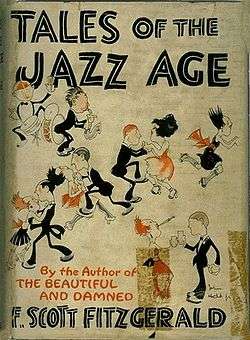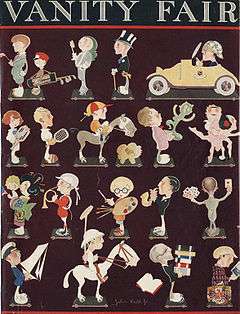John Held Jr.
| John Held Jr. | |
|---|---|
| Born |
January 10, 1889 Salt Lake City |
| Died |
March 2, 1958 Belmar, New Jersey |
John Held Jr. (January 10, 1889 – March 2, 1958) was an American cartoonist, printmaker, illustrator, and author. One of the best-known magazine illustrators of the 1920s, Held created cheerful art showing his characters dancing, motoring and engaging in fun-filled activities. The drawings depicted the flapper era in a way that both satirized and influenced the styles and mores of the time, and his images have continued to define the jazz age for subsequent generations. He also produced linocuts that depicted a Victorian era that was dark with violence and abuse.
Youth

Born in Salt Lake City, he was a son of Annie (Evans) and John Held. His father was born in Geneva, Switzerland, and was adopted by Mormon educator John R. Park, who brought him to Salt Lake City.[1] John Held Senior contributed illustrations to the 1888 The Story of the Book of Mormon.[1] John Held Jr.'s maternal grandfather, James Evans, was an English convert to Mormonism.
Held showed a talent for the arts at a young age. He learned woodcutting and engraving from his father, and sold a drawing to local newspaper at only nine years old.[2] He sold his first cartoon to Life magazine at the age of fifteen, and in 1905 he began working as a sports illustrator and cartoonist at the Salt Lake City Tribune.[2] During his years at the Tribune, he obtained his only formal art instruction with the sculptor Mahonri M. Young, a grandson of Brigham Young.[2] In 1910 Held married Myrtle Jennings, the Tribune's society editor. In 1912 he relocated to New York, and found a job as a graphic designer for an advertising company.[3]
Cartoons and covers

In 1915 Vanity Fair began publishing his drawings, which he signed "Myrtle Held".[3] During World War I he worked for US Naval Intelligence in Central America as an artist and cartographer.[2]
He illustrated many covers for Life during the 1920s, and contributed illustrations for other magazines including Judge and The Smart Set.[3] His work, which quickly became popular, defined the "funny, stylish image of the flapper with her cigarette holder, shingle bob and turned-down hose and of ther slick-haired boyfriend in puffy pants and raccoon coat."[4] He wrote and drew two newspaper comic strips, Margie and Rah Rah Rosalie.[3] In addition to his archetypical flapper illustrations, Held also made linocuts and drew cartoons in a 19th-century woodcut style.[5] From 1925 to 1932, his woodcut-style cartoons and faux maps were published frequently in The New Yorker, founded by his high school classmate Harold Ross. Held created the iconic "Wise Men Fish Here" sign which hung above the door of the Gotham Book Mart for the life of the store.
His post-1930 works are not as well known; during the Great Depression Held lost much of his money in the Ivar Kreuger fraud scheme, and his last New Yorker illustration appeared in 1932. Held wrote and illustrated several novels, such as Grim Youth (1930) and The Flesh Is Weak (1931). He also published The Works of John Held Jr. in 1931. In 1937 he designed sets for the Broadway comedy revue Hellzapoppin. He exhibited his bronze sculptures of horses in New York in 1939.[3] He moved to a dairy farm in Wall, New Jersey in 1945.[1] In the 1950s, popular nostalgia for the 1920s resulted in a revival of interest in Held's earlier works.[6] Held's work appeared in Vanity Fair, Life, Redbook, Harper's Bazaar, and House and Garden.[1]
Held died in 1958 at age 69 of throat cancer.[1] John Held, Jr. is interred at Woodlawn Cemetery in The Bronx, New York City.
Style
Held admired the caricatural quality of Greek vase painting,[7] and was inspired by the Mayan geometric designs he saw during his time in Central America in 1917.[8] The angular style of Held's drawings depicting the Twenties has sometimes been associated with Art Deco.[8]
Corey Ford described Held as both a recorder and a setter of popular styles and manners:
His angular and scantily clad flapper was accepted by scandalized elders as the prototype of modern youth, the symbol of our moral revolution ... Week after week in Life and Judge and College Humor, they danced the Charleston with ropes of beads swinging and bracelets clanking and legs kicking at right angles ... So sedulously did we ape his caricatures that they lost their satiric point and came to be a documentary record of our time.[9]
Personal life
John Held Jr. was married four times. He married Myrtle Jennings in 1910. After a divorce, he married Ada Johnson in 1918. During the 1920s the couple adopted three children. Following a divorce in 1931, Held married a beauty pageant contestant in 1932, and had a daughter. In 1942 he married Margaret Schuyler Janes.[3]
References
- 1 2 3 4 5 Nelson, Glen (September 2010). "Jazz-Age Cartoonery: John Held, Jr. and the New Yorker" (PDF). Sunstone (160): 2–5. Retrieved 20 July 2016.
- 1 2 3 4 Held, John. 1972. The Most of John Held, Jr. Brattleboro, Vt: S. Greene Press. p. 16. ISBN 0828901678.
- 1 2 3 4 5 6 Held, John. 1972. The Most of John Held, Jr. Brattleboro, Vt: S. Greene Press. p. 144. ISBN 0828901678.
- ↑ Bowen, Ezra. 1974. This Fabulous Century: 1920–1930. New York: Time-Life Books. p. 51. OCLC 923191208.
- ↑ Sayle, Joel. "Michelangelo of the Flapper". Life. November 4, 1972. p. 20.
- ↑ Held, John. 1972. The Most of John Held, Jr. Brattleboro, Vt: S. Greene Press. p. 12. ISBN 0828901678.
- ↑ Held, John. 1972. The Most of John Held, Jr. Brattleboro, Vt: S. Greene Press. p. 13. ISBN 0828901678.
- 1 2 Held, John. 1972. The Most of John Held, Jr. Brattleboro, Vt: S. Greene Press. p. 18. ISBN 0828901678.
- ↑ Held, John. 1972. The Most of John Held, Jr. Brattleboro, Vt: S. Greene Press. p. 19. ISBN 0828901678.
External links
https://archive.org/details/worksjoh00held